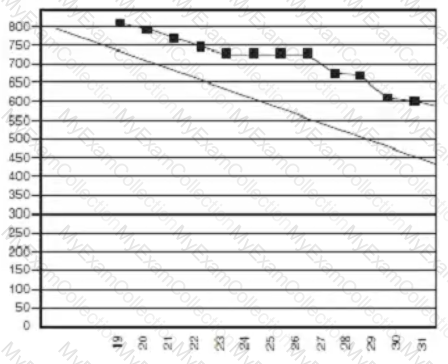A product owner has various items in a product backlog and does not know how to prioritize them. How should the agile practitioner coach the product owner?
A team member on a self-directed team is concerned that a feature the customer wants is outside of what the team will be able to deliver. What should the team member do next?
What should a learn consider when calculating the effort needed to complete a product backlog?
A project was delivered in a foreign country for a big customer, but there are a lot of complaints about the way the functionality was implemented. Now there is a new project to fix the defects of the first one.
What strategy should be used to deliver it successfully?
An agile learn has been in place (or five years and the customer is satisfied with the team's performance and deliverables. Now that the product is buill and delivered, the customer is considering the future role of the Scrum Master.
What should the customer do?
During backlog refinement, the team uses an online planning poker tool for estimation. The junior developers change their number of story points after they see the estimations provided by the developers. The junior developers state that the reason for this is that they do not have enough experience and do not want to be blamed for sizing it wrong.
What should the scrum master do?
A healthcare agency has contracted a vendor to provide a financial accountability solution. During a daily coordination meeting, the lead developer reports they cannot complete the stories for this iteration because the project director requested a document detailing all testing planned for the solution. The team lead met with the project director to discuss alternatives but insists they need the detailed plan by the end of that week. The team lead advises the lead developer to continue coding.
What should the team lead do next?
A team's technical lead believes that manual testing tasks should be conducted by junior team members below their level. The junior team members think it is unfair and refuse the tasks.
What should the scrum master do?
A high-profile project team is struggling to meet planned velocity. During a retrospective, the team agreed that their lack of experience in the technology resulted in an excess of rework.
What should be done to resolve this challenge?
A new CIO advocates an agile framework for new IT projects, but the team has reservations. How should the CIO ensure that the team will be aligned with this?
A development team has started working on a new service but is unsure if the service fits the customer's requirements. What should the product owner do to ensure that the service will benefit the customer?
An agile project manager is leading an international project involving a global team consisting of members from very different cultures, countries, and time zones. The agile project manager is aware that similar projects with distributed teams have led to serious conflicts.
What should the agile project manager do to promote trust and collaboration?
A Talk with the human resources (HR) department to select team members with similar backgrounds to eliminate conflict
B. Collocate for team building to promote collaboration to build trust and improve communication.
C. Promote a project charter with the project vision and purpose to help align the team.
D Promote a team charter with a set of norms rules and agreements to facilitate the work
The scrum master for a large project must provide an estimate of what can be delivered in six months What should the scrum master do?
During a coaching session, an agile project manager discussed embracing communication to keep all stakeholders aligned. The agile project manager recently had a discussion with their team and decided to display a product roadmap.
What is the agile project manager trying to show?
What should a product owner do when a new stakeholder is complaining that they are not receiving the relevant financial data regarding the project.
A product owner complains that some of the requirements identified several iterations ago have not been implemented. The product owner wants to know why the status of these requirements was not communicated.
What should the Scrum Master do?
A manufacturing shop is using Kanban to plan, visualize workflow, and limit work in process (WIP). Which productivity key performance indicator (KPI) should the team lead be monitoring on a regular basis?
An agile team lead is assigned to a project that must ensure data security. What should the team lead do to guarantee that security, as a non-functional requirement, is managed throughout the project?
A customer has given a project team several requests for new features on a product. The customer is upset that the requests have been placed in the backlog and are not currently being worked on by the team.
What should the team do next?
An agile project has three more iterations before the release. There is a lot of report functionality to be created and defects to be cleared. During a daily scrum, a team member suggests a timebox spike to find a more efficient way to deliver reports.
What should the project leader do?
During a retrospective, team members suggest process improvement ideas. The agile team lead knows that, while many of these ideas are different from standard practices, a few of them are good. What should the agile team lead do?
A project team identifies a number of technical challenges with features in the next sprint What should they do?
A new agile project leader habitually becomes involved in the work from a support perspective and uses information radiators to ensure that all actions to remove impediments are visible to the team. What is the agile project leader doing?
During initial planning, a project team investigates several approaches to building new application software, emphasizing the most valuable deliverables. The team needs to convince stakeholders and win their approval.
How can the project team achieve this?
During a sprint review the product owner identifies a required improvement for a feature's user interface (UI) delivered during the sprint What should the product owner do next?
The product owner of a team starts the iteration review with a quick walkthrough of the iteration goal, the list of planned stories with status and a demo of all the stories to the business. What should the product owner have done differently?
A product owner worked with the customer to define the success criteria for the launch of a new product in the manufacturing industry. The project team responsible for development is seeking guidance on what to develop first.
Which two actions should the product owner take? (Choose two.)
While attending a conference, an agile practitioner learns of a new user interface (Ul) framework that could benefit the team. What should the agile practitioner do next?
Over the last two sprints, a number of potential problems have threatened the team's ability to hit the targeted release date. What should the agile practitioner do?
The team is derailed by a demand from a senior manager unrelated to the project. How does the agile coach help the team?
A Scrum Master would like to provide information to key stakeholders on the daily resource and project activities. Which tool should the Scrum Master use to provide these updates?
The amount of information captured in the project's defects is varying within the development team. Team members are becoming frustrated with the defect quality inconsistencies and the frequent clarification required.
What should be done to address the issue?
Senior management is frustrated at the lack of a detailed implementation plan that shows exactly when the project will end and when all requirements will be met. The team has been using a rolling wave planning approach so far on the project.
How should the agile practitioner explain to senior management the benefits of this approach?
A project team member expresses frustration about the length of time it takes to make decisions for a complex project. Approvals needs to happen at many levels in the company.
What should the team lead do to improve decision quality and reduce the time required to make decisions?
A project team has been working on a new application. The application is technically challenging, because the team is using new technology unknown to the development team and business requirements are unclear. The product owner has been working closely with the stakeholders to ensure alignment with requirements and other issues. The agile lead is working with the team and product owner on the product backlog.
What is the role of the team?
An agile practitioner is in the process of refining requirements. The requirements keep changing based upon with whom the agile practitioner speaks.
What should the agile practitioner do in this situation?
A company president is concerned about the impact of a natural disaster on the company. How should management identify areas to apply its resources and mitigate potential impacts?
A large project team of 20 people from different functional areas has just been formed and the project starts next week. The team will be working on a regulated and strictly controlled pharmaceutical product but does not have subject matter expertise.
Which two actions should the scrum master take as priorities? (Choose two.)
A large project team of 20 people from different functional areas has just been formed and the project starts next week. The team will be working on a regulated and strictly controlled pharmaceutical product but does not have subject matter expertise.
Which two actions should the scrum master take as priorities? (Choose two.)
Some members of an agile project team work remotely, so it is difficult to have regular face-to-face backlog grooming sessions. How should the agile practitioner ensure that the team is able to reduce miscommunication and rework in this environment?
During a current sprint, a team member asks permission from the scrum master to investigate an alternative design approach What should the scrum master do?
A newly formed scrum team wants to foster an environment of transparency and experimentation. The team decides to use a Kanban board to record and track encountered impediments Emphasis is placed on how issues are resolved and the strategies for preventing them in the future Over time what will be the result of this approach?
A Kanban team is struggling to prioritize and determine which tasks to handle first according to value. What should the team do to improve this situation?
During sprint retrospectives, some team members are very vocal and tend to dominate the conversation, while others are more reserved and less likely to participate. What should the scrum master do?
After conducting the second retrospective with project stakeholders, the customer expresses frustration. The customer wants a more predictable roadmap for the delivery of features and functionalities.
How should the project manager respond to the customer?
When considering impact on a project, to whom should an agile project manager give top priority on the stakeholder list?
A Scrum team has worked hard to reach their sprint goal, but impediments have prevented them from succeeding. The team needed help from a specialist on another team, but the specialist was on a 2-week vacation.
What should the scrum master do?
During the review session, the product owner discovers that the user interface has a response time of 10 seconds. The non-functional requirements state that it should respond in less than two seconds. The team complains that this requirement was not communicated to them.
What should have been done to avoid this?
An agile team has been given a complex project with a basic set of requirements which need further elaboration and review. How should the team iteratively build out the backlog of requirements with the stakeholders?
During iteration planning, it was determined that an epic should be decomposed What was the determining factor?
During a team meeting members who are subject matter experts (SMEs) mention that they are continuously working on repetitive tasks which has lowered motivation. What should the agile practitioner do?
A project team has a senior subject matter expert (SME) who is comfortable with data integration. The SME is not inclined to perform regression testing because the SME feels that performing regression testing is more of a junior duty.
What should the scrum master do?
A mature agile team welcomes a new member Due to poor experiences with a previous team, the new member is reluctant to communicate.
What should the agile project leader do?
During a retrospective, the team agrees that they have limited competence in using a newly introduced tool. What should the team do?
On an agile project, it is important to identify and engage business stakeholders throughout the project and to ensure the team understands the stakeholders' business needs. Which option supports this idea?
An organization strives hard to accelerate value delivery by improving product design, development, and transition activities. What ways of working should the organization discontinue to become an effective player?
An agile project manager has noticed their teams declining morale, mistrust, and isolation over the last 6 months of working on a project. What should the agile project manager do to enhance productivity and create a cohesive team culture?
The agile coach of a development team uses a servant leadership approach. The team is starting the third iteration of an upgrade to a software product, and work is going slower than initially planned.
What should the coach do to help the team?
A large project team is assigned to a complex technical project with many interdependent epics. The team starts to experience problems in the second sprint as the technical leads are independently unable to determine the needed solutions.
What should the project lead do to help the team?
Following a successful product release, senior management asks an agile team how to improve the value of the product for the next release. What should the team do?
A scrum team has conducted regular retrospectives to discuss immediate concerns and the implementation of improvement actions. Despite this, after a few iterations, the same concerns resurface. What should the team have done to improve retrospective outcomes?
A scrum master of a team that is new to Scrum wants to share the purpose of the daily coordination meeting. What should the scrum master tell the team?
The customer needs assistance in determining the efficiency of a set of process activities within the solution. What should the agile team do?
During backlog refinement meeting, the new developer on the team asks the product owner to discuss a new performance threshold requirement and how it impacts the stories in the backlog. What should the team do?
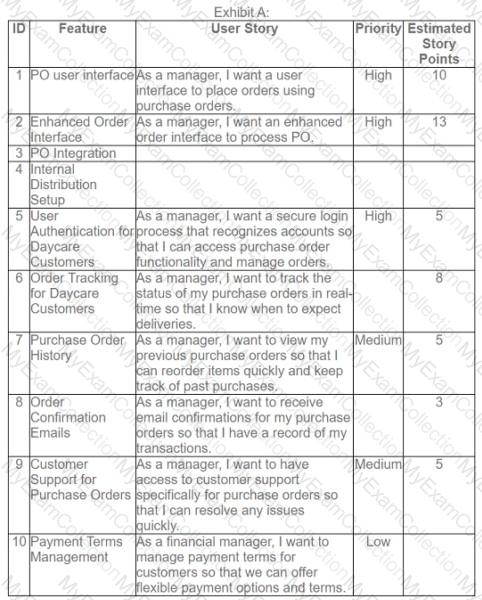
A food company seeks additional business-to-business (B2B) revenues from some customers by
implementing purchase order (PO) functionality. To achieve this, the agile project team is exploring PO integration options (see item #3 in Exhibit A), as the product increment (PI) planning process is underway.
What should the project team do next?
An agile team and a traditional development team are working together on a project. Each team exceeds expectations regarding deliverables: however, issues arise when the deliverables are integrated. What should the agile practitioner do?
At the retrospective, the burndown chart shows that the project is slightly behind schedule. The project team identifies an inexperienced software engineer as the source of reduced velocity. How should the project team address this issue?
During an executive review, a scrum master uses a burndown chart to demonstrate team deliverables through time. The scrum master declared that velocity increased from 27 to 35 over the last 3 sprints, but one of the executives asks to clarify the importance of these metrics.
How should the scrum master respond?
An executive requests information regarding a sprint status. What action should the product owner take?
An agile learn has only one database administrator with the necessary knowledge of database-related tasks. The project manager identifies the risk that if this person leaves, team velocity will significantly decrease.
What should the agile coach do?
A seven-member agile team's composition varies considerably in age. gender, culture, personality type, and professional background. When planning a team-building event, what type of interpersonal skills should the project leader use?
The product owner working on an agile software development project has brought all the Scrum team members together for the first sprint planning meeting. The team has read the user stories and has provided estimates to complete these user stories. The product owner plans to empower the team to get the work done.
What is this an example of?
A large, corporate organization is forced to hire new team members in a geographically remote location from the current team. The manager of the department is concerned about the team not being colocated.
What behavior would indicate the team is not working well together?
A project's product owner asks the scrum master to facilitate the estimation activity. The scrum master then meets with the team and the product owner to clarify the user stories. Following the meeting, the team assembles and provides individual user-story estimates.
What technique did the team use?
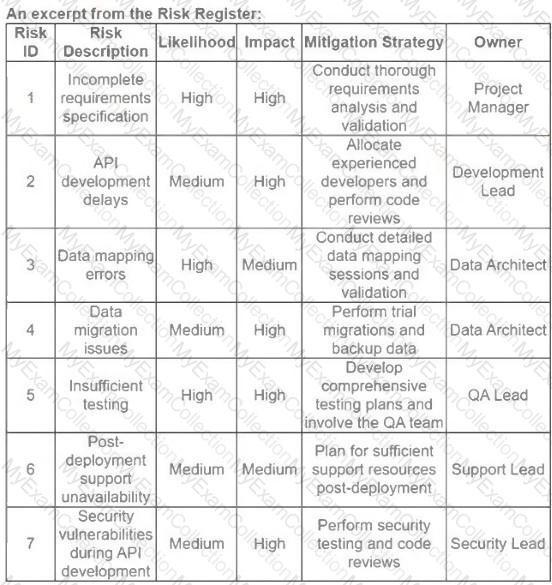
An e-commerce company acquired a tool to customize subject line generation for marketing campaigns. In sprint planning, the team discussed integrating this tool with the customer relationship management system.
Which mitigation strategy is most appropriate to ensure the final product meets the business objectives? (Refer to the Risk Register Exhibit)
Several potential risks have been identified for a new project that started last month. The project manager is worried that the team is not fully aware of these potential threats.
What should the project manager do?
The product owner is very concerned about work not being completed and tested before a hard release date. What can the agile team do to mitigate this risk?
A team member has spent 5 days on a spike and the first set of experiments has not been successful. The issue is the development team member has determined a short-term rather than a long-term solution.
What should the project leader do?
A backlog for a project has been prioritized and a sprint has begun. A security issue has been revealed that needs to be addressed or large security vulnerabilities will be exposed.
How should the project manager proceed?
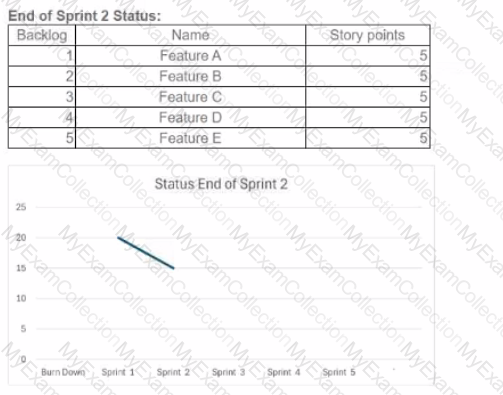
Case Study
An agile project lead for a company is leading a sales team who has committed to delivering new product functionality to the customer at the end of five sprints. The agile project lead performed initial planning with the team and with the team's support has committed to the scope and deadline.
Check in with the project in three stages to answer the associated questions.
How do two additional features and more story points added by the product owner impact the team's progress and ability to complete work within the iteration, considering the burndown rate of the team has not changed? (Refer to the Case Study and End of Sprint 3 Exhibit)
During refinement, the team tester has a question about part of the acceptance criteria for a given user story. Who should clarify the acceptance criteria?
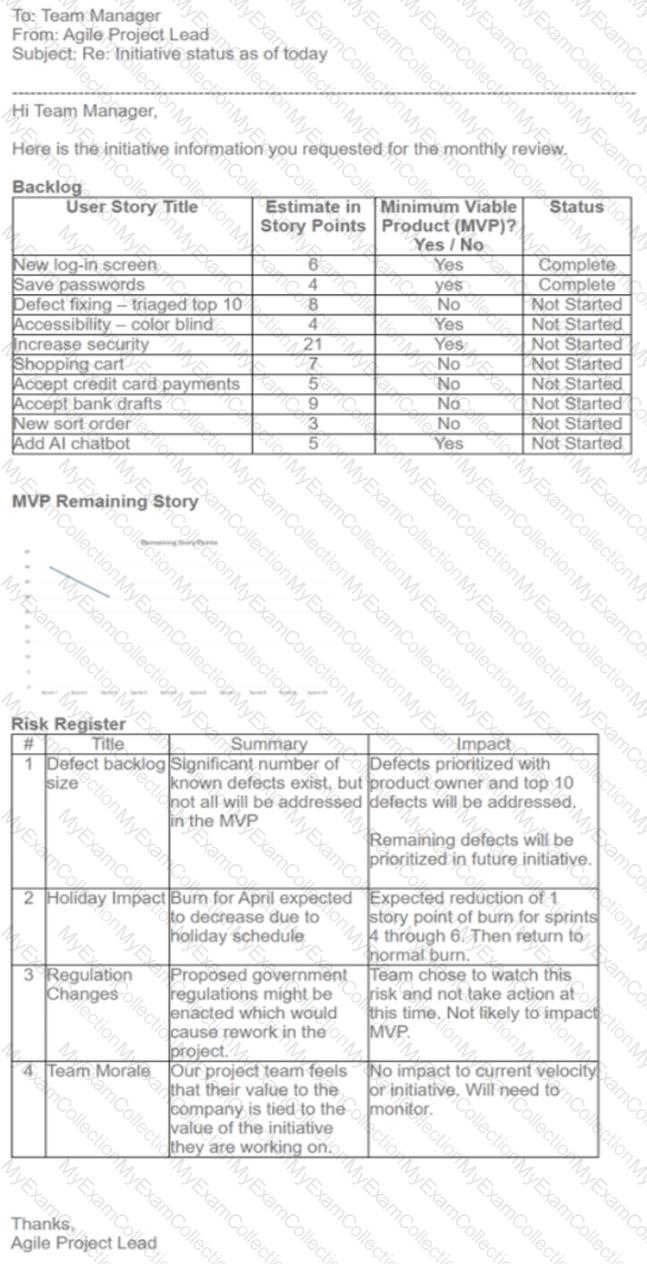
The manager of the team is responsible for delivering a specific initiative within the organization. They are preparing for the monthly project review meeting, where they will present the current state of this initiative. The agile project lead sends the manager the following email with the initiative's current status.
Which summaries are correct and will be presented during the monthly project review? (Refer to
the email and exhibits to the Team Manager)
An agile team has received several new features to be added to the product backlog. The team is struggling to provide a reasonable estimate for feature development due to a lack of experience.
How should an experienced agile practitioner assist the team?
A scrum master wants to encourage better collaboration within a collocated team and is coming up with a visualization method for the project. How could the scrum master promote transparency?
A scrum master is observing the daily coordination meeting of an agile development team. The scrum master realizes that one of the developers is confused about a business rule for the solution they are building.
How should the scrum master address this issue?
Two agile teams from different company sites need to work and collaborate on the same project. What is the first action the agile project manager should take in order to ensure a smooth collaboration between the two teams?
An agile coach has been hired to improve the performance and quality of developed software. The coach performed an analysis of the software and discovered an excessive number of escaped defects, leading to external failures.
How can the agile coach effectively address and correct defects in the software development process while maintaining predictability and keeping workloads within capacity?
During the fourth sprint retrospective for an IT project, the team members develop a series of actions to improve problem solving in the next sprint. However, many team members are concerned that these actions will not be implemented, since there was no follow-up from the last retrospective meeting.
What should the scrum master do to improve team commitment to the recommendations from the retrospective meeting?
The vice president (VP) of an organization has been asked by the chief information officer (CIO) to have their teams to embrace an agile approach to projects. The VP, however, often insists teams use a more predictive approach to project management which allows the project managers to do what they like.
How should an agile team member coach the VP and teams be more effective?
During a backlog refinement meeting, a senior team member raises a concern about an epic sizing that requires the use of a new interface for a vendor product. The product owner acknowledges this as a risk. What should the product owner do now?
A global organization is migrating its IT infrastructure from traditional, physical assets to cloud-based assets. Agile concepts are new to the organization because it currently uses a predictive approach.
What should an agile coach do to facilitate a culture change to an agile approach?
A scrum team has eight developers, but only two are database engineers. During the last few retrospectives, the team identified that most sprint stories are dependent upon database engineers. This has created a bottleneck in completing stories.
What should be proposed to the team?
The product owner of an agile project is frustrated because the team is unable to deliver as many features as expected. The product owner asks the team to reduce test-automation levels, since the quality assurance team will test the product at project completion. The product owner expects that more features will be delivered in each iteration using this approach.
What should the agile practitioner do?
A new project starts and team members are pooled together to execute it. The team works together and moves from the forming stage into the storming stage. However, potentially destructive conflicts are now arising.
What should the agile coach do to develop members into a high-performance team?
A project is to be started with a team of nine existing and nine new members. The scrum master feels that the team is too large and wants to break it into three teams. The scrum master sets aconstraint that each team have an equal number of existing team members for knowledge sharing and experience.
What should the scrum master do to accomplish this?
An agile team is building a training safety video based on current government regulations. The agile coach knows the regulations are likely to change before the release date.
How should the agile coach address this change?
A project team's standups often run over the allotted time as members attempt to resolve issues. With a large team, this is leading to productivity impacts and bringing complaints from some members that the meetings are wasting their time when they are not directly involved in an issue’s resolution.
How can the project leader help to manage the team's time?
A team member has asked a question about the responsibilities of the product manager, QA, and the team regarding quality. What should the agile project manager advise?
A key stakeholder feels they do not understand the project at a comprehensive level. What should the agile practitioner do?
An agile team has started to worry because lately they have seen an increase in the number of issues. There seems to be a large variance in the quality of the work items delivered. The team now realizes that a shared understanding of quality may not exist among team members.
What should the team do?
An agile coach is working on a digital transformation project. The project team is in the middle of a 5-week sprint. The agile coach notices constant arguing among team members on what should be the preferred technical approach to solve a current business problem. What can the agile coach do to promote collaboration and consensus-building among team members?
An infrastructure team had to revamp so downstream channels could consume data from the data lake, thereby improving operational efficiency for the end customers. Which primary components should the product manager consider while plotting performance and dependencies on the product roadmap?
How can a project team effectively work toward a common goal and communicate as they scale and expand to build a new business-critical platform, given that they have been responsible for a small customer-facing product with little complexity over the past 2 years?
During the high-level estimation for a project, the team contacted the product owner about the client’s requirements. The team is seeking guidance as their estimate is too big and there is a risk of not finishing the project in time.
What should the product owner do to help the team?
A team member on a new scrum project previously provided support to another application Due to issues with that application, the team member's former supervisor continues assigning them tasks related to that project. The new project's scrum master includes this issue in the risk register.
What should the scrum master do next?

Based on the backlog metrics in the chart what can explain the jump in points at the end of iteration 4?
In a scrum team, who should be responsible for the budget and release plans?
During a daily stand up meeting, a developer expresses concerns that the selected technology limits the number of concurrent users. What should the agile team lead do?
A project has several features that will deliver immediate customer value. The product owner needs to determine which features to include in the upcoming iteration.
What should the product owner have the customer review and approve?
Midway through a sprint, a scrum team member advises the team of a new requirement that may change the initial scope. What should the team do?
An agile team is struggling to achieve their goal during the first release due to an unstable environment beyond the authority of the product owner. Close to the end of the current sprint, the release manager resigns and a new person takes over.
What should the scrum master do?
An agile team is struggling to achieve their goal during the first release due to an unstable environment beyond the authority of the product owner. Close to the end of the current sprint, the release manager resigns and a new person takes over.
What should the scrum master do?
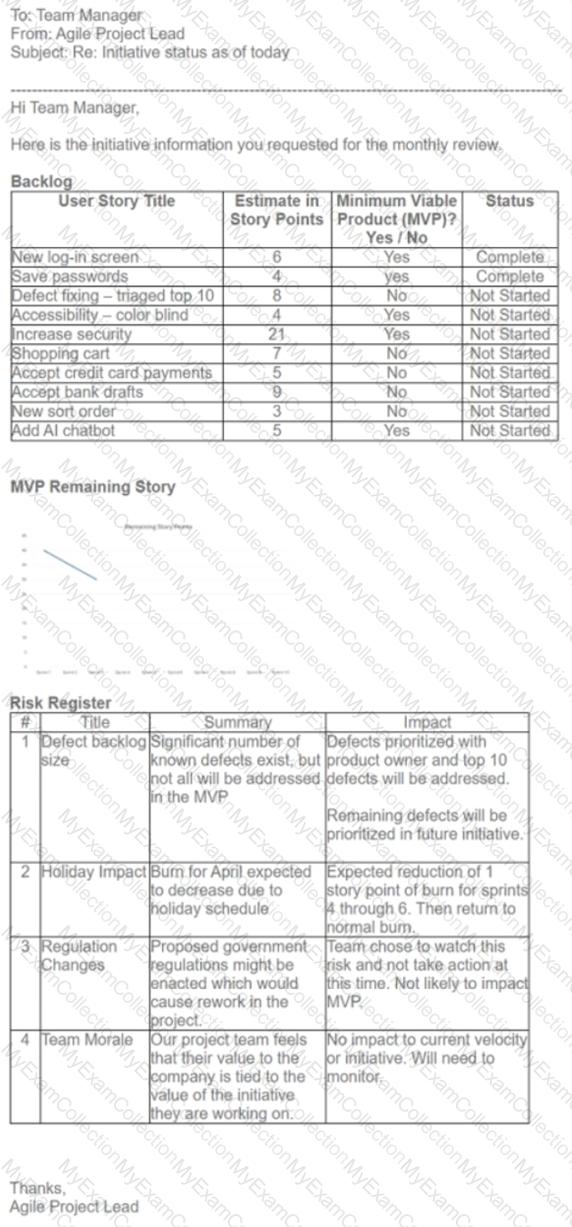
A project team's manager is responsible for delivering a specific initiative for the organization. They are preparing for a monthly meeting where the manager will present on the current state of this initiative. The agile project lead sends the manager the following email with the current initiative status (see Exhibit A).
How many sprints will be needed to complete the entire backlog?
A team member does not understand what the project risks are or the impact that they could have. How should an agile leader communicate risks in a way that the team will understand?
How can an agile project manager ensure that all stakeholders have a clear understanding of the release plan by the end of a release planning meeting? (Choose two.)
In a project, the customer asks for a requirement that clearly deviates from the contract terms. How should the contractor react?
A mobile application project is halfway through development. The team reaches a stabilized velocity after 8 iterations. The sprint duration is two weeks and requirements assigned by the product owner are not changing frequently.
What is the estimated time remaining for the project?
A team working with a new technology faces a significant amount of uncertainty about its ability to deliver stories due to technical issues. What should the team do?
An agile team provides feedback that user stories include insufficient details to understand the requirements. What should the agile practitioner do?
During an agile team retrospective, some junior team members discussed an approach that could improve the overall team performance. How should the agile practitioner handle the recommendation?

A scrum master is overseeing the launch of a chatbot for the service desk. Complaints come up post-release about edge case responses to queries. After analyzing the issues, the business decision was made to take the chatbot offline, resulting in workflow disruptions and risking the reputation.
How could this situation have been avoided? (Refer to Testing Protocol Table)
The agile team disagrees with the business stakeholders on completing some epics What could help eliminate misunderstandings?
During product development, changes in technology and regulations require the team to reassess product architecture How should this technical debt be captured?
A user interface (UI) developer has features for channels ready for review. During the team review, the architect is disappointed that Splunk software has not been implemented for better server and client logs. The architect insists on the implementation of Splunk software, which will impact the release date.
Which one of the following is the ideal option for the team to resolve this conflict?
During a six-week iteration, an issue is identified by a team member. After analysis, the team member determines that it will take at least two weeks to resolve. What should the team member do?
At an iteration review, the product owner indicated that the work delivered did not meet expectations. The project team is surprised.
How should this situation have been prevented?
A scrum master assumes a project that is essential to organizational growth. The project is expected to be in production for three years. What should the scrum master do first?
A business analyst has been assigned to optimize a process to deliver healthcare services to patients in a clinic. In creating a value stream map, what will the business analyst’s key observations include?
Midway through a two-week sprint, an agile team realizes that the features cannot be delivered within the sprint. The team determines that another week will be required to complete all committed features.
What should the team do?
A project team tasked with delivering a solution with extremely aggressive timelines is facing an issue with meeting their sprint velocity targets. To address this issue and bring the project back on track, what action should the team take?
An agile team is under pressure to deliver an application. The product owner anticipates many change requests from customers once the product is released.
What should the agile team do?
During a Kanban team's daily stand up, an agile coach observes that the team seems disinterested in the work status. While it appears that there are no issues with flow, there is a marked lack of attention to team effort. When the agile coach queries the team for reasons, members explain that work continues to be scheduled with no end in sight.
What should the agile coach do?
A product owner with experience in a predictive approach wants the team to develop very detailed schedules and cost estimates for the next 10 sprints. What should the Scrum Master do?
A development team, new to scrum, questions the need to collect metrics on team performance. While learn members understand velocity and burn down, they feel that once velocity becomes settled it is needless to keep track.
What should the agile coach tell the team?
During sprint planning, team members have differing opinions on a feature that delivers business value but fails to provide a long-term solution for the customer How should the team resolve this?
How should a project leader manage stakeholder expectations in an agile project?
During team meetings, the team often struggles with making decisions about their technical approach. What should be done to improve the quality and timeliness of decisions?
During a review session, an agile team presented done requirements to a group of stakeholders Stakeholder feedback indicated that the done requirements failed to meet the most pressing needs and provide value.
What should the team have done to prevent this?
A legal department representative contacts the scrum master because, while the project's budget has been maintained, it has exceeded its original contracted time and scope What should the scrum master do?
 Assess dependencies and integration requirements more effectively.
Assess dependencies and integration requirements more effectively. Prioritize and deliver in smaller, testable increments.
Prioritize and deliver in smaller, testable increments. Improve estimation accuracy using techniques like planning poker.
Improve estimation accuracy using techniques like planning poker. Ensure alignment with agile principles of incremental and iterative delivery.
Ensure alignment with agile principles of incremental and iterative delivery. The product owner needs to understand the impact of the security issue on the product's value and determine if it needs to be prioritized over other work in the sprint.
The product owner needs to understand the impact of the security issue on the product's value and determine if it needs to be prioritized over other work in the sprint. The project team should help evaluate the effort required to address the issue and ensure that the solution is feasible within the sprint’s capacity.
The project team should help evaluate the effort required to address the issue and ensure that the solution is feasible within the sprint’s capacity. Accessibility – color blind (4 story points)
Accessibility – color blind (4 story points) Increase security (21 story points)
Increase security (21 story points) Add AI chatbot (5 story points)
Add AI chatbot (5 story points) MVP Completion: The risk register mentions a burn reduction for sprints 4-6 due to holiday schedules.
MVP Completion: The risk register mentions a burn reduction for sprints 4-6 due to holiday schedules. If the burn rate is consistent after sprint 6, the MVP will be completed by sprint 9.
If the burn rate is consistent after sprint 6, the MVP will be completed by sprint 9. The entire backlog is projected to complete by sprint 16 assuming no further deviations.
The entire backlog is projected to complete by sprint 16 assuming no further deviations.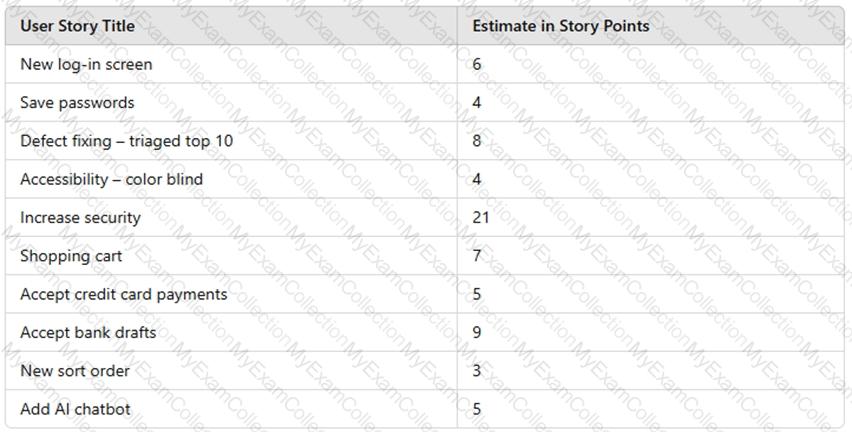
 Normal sprint velocity: 5 story points per sprint
Normal sprint velocity: 5 story points per sprint Reduced velocity for sprints 4-6: 4 story points per sprint
Reduced velocity for sprints 4-6: 4 story points per sprint First 3 sprints: 5 points per sprint → 5 × 3 = 15 story points completed
First 3 sprints: 5 points per sprint → 5 × 3 = 15 story points completed Sprints 4-6: 4 points per sprint → 4 × 3 = 12 story points completed
Sprints 4-6: 4 points per sprint → 4 × 3 = 12 story points completed Remaining story points after sprint 6: 72 - (15 + 12) = 45 story points
Remaining story points after sprint 6: 72 - (15 + 12) = 45 story points Remaining sprints needed at normal velocity (5 story points per sprint): 45 ÷ 5 = 9 sprints
Remaining sprints needed at normal velocity (5 story points per sprint): 45 ÷ 5 = 9 sprints Sprints 1-6: Already planned.
Sprints 1-6: Already planned. Additional 9 sprints needed.
Additional 9 sprints needed. The project is halfway through development.
The project is halfway through development. The team has reached a stable velocity after 8 iterations.
The team has reached a stable velocity after 8 iterations. Each sprint duration is two weeks.
Each sprint duration is two weeks. Since the project is halfway completed, an equal amount of work remains.
Since the project is halfway completed, an equal amount of work remains. If 8 iterations have been completed, 8 more iterations are required to complete the project.
If 8 iterations have been completed, 8 more iterations are required to complete the project. Each iteration (sprint) lasts 2 weeks.
Each iteration (sprint) lasts 2 weeks. 8 iterations × 2 weeks per iteration = 16 weeks.
8 iterations × 2 weeks per iteration = 16 weeks. 16 weeks = 4 months.
16 weeks = 4 months.